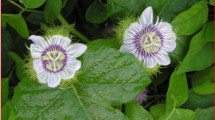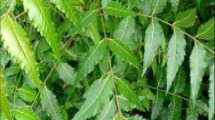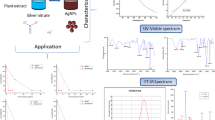Abstract
Diseases transmitted by blood-feeding mosquitoes, such as dengue fever, dengue hemorrhagic fever, Japanese encephalitis, malaria, and filariasis, are increasing in prevalence, particularly in tropical and subtropical zones. To control mosquitoes and mosquito-borne diseases, which have worldwide health and economic impacts, synthetic insecticide-based interventions are still necessary, particularly in situations of epidemic outbreak and sudden increases of adult mosquitoes. Green nanoparticle synthesis has been achieved using environmentally acceptable plant extract and eco-friendly reducing and capping agents. In view of the recently increased interest in developing plant origin insecticides as an alternative to chemical insecticide, in the present study, the adulticidal activity of silver nanoparticles (AgNPs) synthesized using Heliotropium indicum plant leaf extract against adults of Anopheles stephensi, Aedes aegypti, and Culex quinquefasciatus was determined. Adult mosquitoes were exposed to varying concentrations of aqueous extract of H. indicum and synthesized AgNPs for 24 h. AgNPs were rapidly synthesized using the leaf extract of H. indicum, and the formation of nanoparticles was observed within 6 h. The results recorded from UV–vis spectrum, Fourier transform infrared, X-ray diffraction, scanning electron microscopy, and transmission electron microscopy support the biosynthesis and characterization of AgNPs. The maximum efficacy was observed in synthesized AgNPs against the adult of A. stephensi (lethal dose (LD)50 = 26.712 μg/mL; LD90 = 49.061 μg/mL), A. aegypti (LD50 = 29.626 μg/mL; LD90 = 54.269 μg/mL), and C. quinquefasciatus (LD50 = 32.077 μg/mL; LD90 = 58.426 μg/mL), respectively. No mortality was observed in the control. These results suggest that the leaf aqueous extracts of H.indicum and green synthesis of AgNPs have the potential to be used as an ideal eco-friendly approach for the control of the A. stephensi, A. aegypti, and C. quinquefasciatus. This is the first report on the adulticidal activity of the plant extracts and AgNPs.







Similar content being viewed by others
References
Arjunan NK, Murugan K, Rejeeth C, Madhiyazhagan P, Barnard DR (2012) Green synthesis of silver nanoparticles for the control of mosquito vectors of malaria, filariasis, and dengue. Vector- Borne Zoonotic Dis 12(3):262–268
Ashraful Alam M, Rowshanul Habib M, Nikkon F, Khalequzzaman M, Rezaul Karim M (2009) Insecticidal activity of root bark of Calotropis gigantea L. against Tribolium castaneum (Herbst). World J Zool 4(2):90–95
Bagavan A, Rahuman A, Kamaraj C, Geetha K (2008) Larvicidal activity of saponin from Achyranthes aspera against Aedes aegypti and Culex quinquefasciatus (Diptera: Culicidae). Parasitol Res 103(1):223–229
Bansal SK, Singh KV, Kumar S (2009) Larvicidal activity of the extracts from different parts of the plant Solanum xanthocarpum against important mosquito vectors in the arid region. J Environ Biol 30(2):221–226
Barik TK, Kamaraju R, Gowswami A (2012) Silica nanoparticles: a potential new insecticide for mosquito vector control. Parasitol Res 111:1075–1083
Cavalcanti ESB, Morais SM, Lima MAA, Santana EWP (2004) Larvicidal activity of essential oils from Brazilian plants against Aedes aegypti L. Mem Inst Oswaldo Cruz 99:541–544
Chaiyasit D, Choochote W, Rattanachanpichai E, Chaithong U, Chaiwong P, Jitpakdi A, Tippawangkosol P, Riyong D, Pitasawat B (2006) Essential oils as potential adulticidal against two populations of Aedes aegypti, the laboratory and natural field strains, in Chiang Mai province, Northern Thailand. Parasitol Res 99:715–721
Chander R, Srivastava V, Tandon JS, Kapoor NK (1995) Antihepatotoxic activity of diterpenes of Andrographis panculata (Kalmegh) against Plasmodium berghei-induced hepatic damage in Mastomys natalensis. Pharm Biol 33:135–138
Choochote W, Tuetun B, Kanjanapothi D, Rattanachanpichai E, Chaithong U, Chaiwong P, Jitpakdi A, Tippawangkosol P, Riyong D, Pitasawat B (2004) Potential of crude seed extract of celery, Apium graveolens L., against the mosquito Aedes aegypti (L.) (Diptera: Culicidae). J Vector Ecol 29:340–349
Chowdhury N, Ghosh A, Chandra G (2008) Mosquito larvicidal activities of Solanum villosum berry extract against the dengue vector Stegomyia aegypti. BMC Complement Altern Med 8:10
Conti B, Canale A, Bertoli A, Gozzini F, Pistelli L (2010) Essential oil composition and larvicidal activity of six Mediterranean aromatic plants against the mosquito Aedes albopictus (Diptera: Culicidae). Parasitol Res 107:1455–1461
Cooper RA, Hartwig CL, Ferdig MT (2005) pfcrt is more than the Plasmodium falciparum chloroquine resistance gene: a functional and evolutionary perspective. Acta Trop 94:170–180
Crobsy DG (1971) Minor insecticides of plant origin. In: Jacobson M, Crobsy DG (eds) Naturally occurring insecticides. Marcel Dekker, New York, pp 171–239
Elango G, Bagavan A, Kamaraj C, Zahir AA, Rahuman AA (2009) Oviposition-deterrent, ovicidal, and repellent activities of indigenous plant extracts against Anopheles subpictus Grassi (Diptera: Culicidae). Parasitol Res 105(6):1567–1576
Feinstein L (1952) Insecticides from plants. In: Insects: The year book of agriculture, USA, Washington. 222–229
Finney DJ (1971) Probit analysis. Cambridge University Press, London 68–78
Gayathri V, Balakrishna Murthy P (2006) Reduced susceptibility to deltamethrin and kdr mutation in Anopheles stephensi Liston, a malaria vector in India. J Am Mosq Cont Assoc 22:678–688
Ghosh A, Chowdhury N, Chandra G (2008) Laboratory evaluation of a phytosteroid compound of mature leaves of day jasmine (Solanaceae: Solanales) against larvae of Culex quinquefasciatus (Diptera: Culicidae) and non-target organisms. Parasitol Res 103:221–277
Govindarajan M (2011a) Larvicidal and repellent properties of some essential oils against Culex tritaeniorhynchus Giles and Anopheles subpictus Grassi (Diptera: Culicidae). Asian Pac J Trop Med 4(2):106–111
Govindarajan M (2011b) Evaluation of indigenous plant extracts against the malarial vector, Anopheles stephensi (Liston) (Diptera: Culicidae). Parasitol Res 109:93–103
Govindarajan M, Mathivanan T, Elumalai K, Krishnappa K, Anandan A (2011) Ovicidal and repellent activities of botanical extracts against Culex quinquefasciatus, Aedes aegypti and Anopheles stephensi (Diptera: Culicidae). Asian Pac J Trop Biomed 1(1):43–48
Govindarajan M, Sivakumar R (2012) Adulticidal and repellent properties of indigenous plant extracts against Culex quinquefasciatus and Aedes aegypti (Diptera: Culicidae). Parasitol Res 110:1607–1620
Harve G, Kamath V (2004) Larvicidal activity of plant extracts used alone and in combination with known synthetic larvicidal agents against Aedes aegypti. Ind J Exp Biol 42(12):1216–1219
Ignacimuthu S (2000) The root of botanicals in combating mosquitoes. Abstracts: Proceedings of symposium on recent trends in combating mosquitoes, Loyola College, Chennai, India, 19
Innocent E, Joseph CC, Gikonyo NK, Moshi MJ, Nkunya MH, Hassanali A (2008) Mosquito larvicidal constituents from Lantana viburnoides sp. viburnoides var kisi (A. rich) Verdc (Verbenaceae). J Vector Borne Dis 45(3):240–244
Jayaseelan C, Rahuman AA , Rajakumar G, Kirthi AV, Santhoshkumar T, Marimuthu S, Bagavan A, Kamaraj C, Zahir AA, Elango G (2011) Synthesis of pediculocidal and larvicidal silver nanoparticles by leaf extract from heartleaf moonseed plant, Tinospora cordifolia Miers. Parasitol Res 109:185–194
Joseph CC, Ndoile MM, Malima RC, Nkunya MH (2004) Larvicidal and mosquitocidal extracts, a coumarin, isoflavonoids and pterocarpans from Neorautanenia mitis. Trans R Soc Trop Med Hyg 98(8):451–455
Kamaraj C, Rahuman AA, Mahapatra A, Bagavan A, Elango G (2010) Insecticidal and larvicidal activities of medicinal plant extracts against mosquitoes. Parasitol Res 107(6):1337–1349
Khanna VG, Kannabiran K (2007) Larvicidal effect of Hemidesmus indicus, Gymnema sylvestre, and Eclipta prostrata against Culex quinquefasciatus mosquito larvae. Afr J Biotechnol 3:307–311
Kirthi AV, Rahuman AA, Rajakumar G, Marimuthu S, Santhoshkumar T, Jayaseelan C, Velayutham K (2011) Acaricidal, pediculocidal and larvicidal activity of synthesized ZnO nanoparticles using wet chemical route against blood feeding parasites. Parasitol Res 109:461–472
Kovendan K, Murugan K, Vincent S, Barnard DR (2012) Studies on larvicidal and pupicidal activity of Leucas aspera Willd. (Lamiaceae) and bacterial insecticide, Bacillus sphaericus against malarial vector, Anopheles stephensi Liston. (Diptera: Culicidae). Parasitol Res 110:195–203
Kumar S, Warikoo R, Wahab N (2010) Larvicidal potential of ethanolic extracts of dried fruits of three species of peppercorns against different instars of an Indian strain of dengue fever mosquito, Aedes aegypti L. (Diptera: Culicidae). Parasitol Res 107(4):901–907
Lee S, Tsao R, Peterson C, Coats JR (1997) Insecticidal activity of monoterpenoids to western corn root worm (Coleoptera: Chrysomelidae), two-spotted spider mite (Acari: Tetranychidae) and housefly (Diptera: Muscidae). J Econ Entomol 90:883–892
Lokesh R, Leonard Barnabas E, Madhuri P, Saurav K, Sundar K (2010) Larvicidal activity of Trigonella foenum and Nerium oleander leaves against mosquito larvae found in Vellore City. Ind Curr Res J Biol Sci 2(3):154–160
Macedo ME, Consoli RA, Grandi TS, dos Anjos AM, De Oliveira AB, Mendes NM, Queiróz RO, Zani CL (1997) Screening of Asteraceae (Compositae) plant extracts for larvicidal activity against Aedes fluviatilis (Diptera: Culicidae). Mem Inst Oswaido Cruz 92:565–570
Maheswaran R, Sathis S, Ignacimuthu S (2008) Larvicidal activity of Leucus aspera (Willd.) against the larvae of Culex quinquefasciatus Say and Aedes aegypti L. Int J Int Biol 2(3):214–217
Marimuthu S, Rahuman AA, Govindasamy R, Thirunavukkarasu S, Arivarasan VK, Chidambaram J, Asokan B, Zahir AA, Elango G, Chinnaperumal K (2010) Evaluation of green synthesized silver nanoparticles against parasites. Parasitol Res 108(6):1541–1549
Marimuthu S, Rahuman AA, Rajakumar G, Santhoshkumar T, Kirthi AV, Jayaseelan C, Bagavan A, Zahir AA, Elango G, Kamaraj C (2011) Evaluation of green synthesized silver nanoparticles against parasites. Parasitol Res 10:2212–2224
Markouk M, Bekkouche K, Larhsini M, Bousaid M, Lazrek HB, Jana M (2000) Evaluation of some Moroccan medicinal plant extracts for larvicidal activity. J Ethnopharmacol 73:93–297
Minjas JN, Sarda RK (1986) Laboratory observations on the toxicity of Swartzia madagascariens (Leguminaceae) extract to mosquito larvae. Trans R Soc Trop Med Hyg 80:460–461
Mohan L, Sharma P, Srivastava CN (2007) Comparative efficacy of Solanum xanthocarpum extracts alone and in combination with a synthetic pyrethroid, cypermethrin, against malaria vector, Anopheles stephensi. Southeast Asian J Trop Med Public Health 38(2):256–260
Murugan K, Mahesh Kumar P, Kovendan K, Amerasan D, Subramaniam J (2012) Larvicidal, pupicidal, repellent and adulticidal activity of Citrus sinensis orange peel extract against Anopheles stephensi, Aedes aegypti and Culex quinquefasciatus (Diptera: Culicidae). Parasitol Res 111(4):1757–1769
Nadkarni AK (2007) Indian materia medica. Pop Prakasham (Mumbai) 1(3):1292–1294
Olagbemiro TO, Birkett MA, Mordue AJ, Pickett JA (1999) Production of (5R, 6S)-6-acetoxy-5-hexadecanolide, the mosquito oviposition pheromone, from the seed oil of the summer cypress plant, Kochia scoparia (Chenopodiaceae). J Agric Food Chem 47:3411–3415
Pancharoen C, Kulwichit W, Tantawichien T, Thisyakorn U, Thisyakorn C (2002) Dengue infection: a global concern. J Med Assoc Thai 85:25–33
Pandey V, Agrawal V, Raghavendra K, Dash AP (2007) Strong larvicidal activity of three species of Spilanthus (Akarkara) against malaria (Anopheles stephensi Liston, Anopheles culicifacies, species C) and filarial vector (Culex quinquefasciatus Say). Parasitol Res 102:171–174
Priyadarshini K, Murugan K, Panneerselvam C, Ponarulselvam S, Jiang-Shiou H, Nicoletti M (2012) Biolarvicidal and pupicidal potential of silver nanoparticles synthesized using Euphorbia hirta against Anopheles stephensi Liston (Diptera: Culicidae). Parasitol Res 111:997–1006
Rajakumar G, Rahuman AA (2011) Larvicidal activity of synthesized silver nanoparticles using Eclipta prostrata leaf extract against filariasis and malaria vectors. Acta Trop 118(3):196–203
Rajasekariah GR, Parab PB, Chandrashekar R, Deshpande L, Subrahmanyam D (1991) Pattern of Wuchereria bancrofti microfilaraemia in young and adolescent school children in Bassein, India, an endemic area for lymphatic filariasis. Ann Trop Med Parasitol 85(6):663–665
Santhoshkumar T, Rahuman AA, Rajakumar G, Marimuthu S, Bagavan A, Jayaseelan C, Zahir AA, Elango G, Kamaraj C (2011) Synthesis of silver nanoparticles using Nelumbo nucifera leaf extract and its larvicidal activity against malaria and filariasis vectors. Parasitol Res 108:693–702
Shelton AM, Wang P, Zhao J-Z, Roush RT (2007) Resistance to insect pathogens and strategies to manage resistance: an update. In: Laceyand LA, Kaya HK (eds) Field manual of techniques in invertebrate pathology. Springer, New York
Sinha S, Pan I, Chanda P, Sen SK (2009) Nanoparticles fabrication using ambient biological resources. J Appl Biosci 19:1113–1130
Sukumar K, Perich MJ, Boobar LR (1991) Botanical derivatives in mosquito control: a review. J Am Mosq Control Assoc 72:210–237
Traboulsi AF, Taoubi K, El-Haj S, Bessiere JM, Ramal S (2002) Insecticidal properties of essential plant oils against the mosquito Culex pipiens molestus (Diptera: Culicidae). Pest Manag Sci 58:491–495
Veerakumar K, Govindarajan M, Rajeswary M, Muthukumaran U (2014) Low-cost and eco-friendly green synthesis of silver nanoparticles using Feronia elephantum (Rutaceae) against Culex quinquefasciatus, Anopheles stephensi, and Aedes aegypti (Diptera: Culicidae). Parasitol Res 113:1775–1785
Veerakumar K, Govindarajan M (2014) Adulticidal properties of synthesized silver nanoparticles using leaf extracts of Feronia elephantum (Rutaceae) against filariasis, malaria, and dengue vector mosquitoes Parasitol Res DOI 10.1007/s00436-014-4077-4
Veerakumar K, Govindarajan M (2013) Green synthesis of silver nanoparticles using Sida acuta (Malvaceae) leaf extract against Culex quinquefasciatus, Anopheles stephensi and Aedes aegypti (Diptera: Culicidae). Parasitol Res 112:4073–4085
Wiseman Z, Chapagain BP (2005) Larvicidal effects of aqueous extracts of Balanites aegyptiaca (desert date) against the larvae of Culex pipiens mosquitoes. Afr J Biotechnol 4(11):1351–1354
World Health Organization (1981) Instructions for determining the susceptibility or resistance of adult mosquitoes to organochlorine, organophosphate and carbamate insecticides: diagnostic test. WHO/VBC/81-807, Geneva
World Health Organization (1995) Vector control for malaria and other mosquito-borne diseases, in WHO Technical Report Series 857, vol 857. World Health Organization, Geneva
Yang YC, Le EH, Lee HS, Lee DK, Ahn YJ (2004) Repellency of aromatic medicinal plant extracts to Aedes aegypti. J Am Mosq Control Assoc 20(2):146–149
Yit HS, Ku-Hua WV, Kumato JH, Mulla MS (1985) Isolation and identification of mosquito repellent in Artemisia vulgaris. J Chem Ecol 11:1297–1306
Zahir AA, Rahuman AA, Kamaraj C, Bagavan A, Elango G, Sangaran A, Kumar BS (2009) Laboratory determination of efficacy of indigenous plant extracts for parasites control. Parasitol Res 105(2):453–461
Acknowledgments
The authors would like to thank the Professor and Head of the Department of Zoology, Annamalai University, for the laboratory facilities provided. The authors would also like to acknowledge the cooperation of staff members of the VCRC (ICMR), Pondicherry and thank Dr. S. Ramesh, Professor and Head, Veterinary College, Vepery, Chennai for TEM analysis.
Author information
Authors and Affiliations
Corresponding author
Rights and permissions
About this article
Cite this article
Veerakumar, K., Govindarajan, M. & Hoti, S.L. Evaluation of plant-mediated synthesized silver nanoparticles against vector mosquitoes. Parasitol Res 113, 4567–4577 (2014). https://doi.org/10.1007/s00436-014-4147-7
Received:
Accepted:
Published:
Issue Date:
DOI: https://doi.org/10.1007/s00436-014-4147-7




